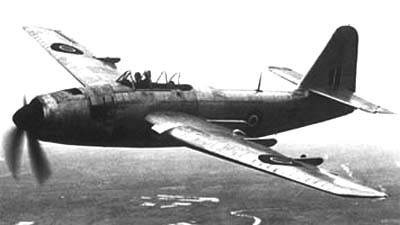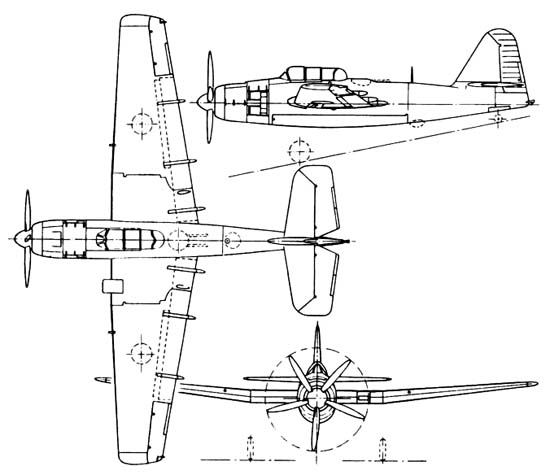BRITISH AVIATION RESOURCE CENTER > EXPERIMENTAL/PROTOTYPES > PREVIOUS PAGE

|
Type: Torpedo bomber Origin: Fairey Aviation Models: Prototypes Crew: N/A First Flight: July 5, 1945 Service Delivery: None Production Termination: None Number Produced: 5 POWERPLANT: Model: Centaurus 57 Manufacturer: Bristol Type: 18-cylinder radial Number: One Horsepower: 2,585 hp Propeller: five-bladed propeller Dimensions: Wing span: 60 ft 0 in (18.3 m) Length: 45 ft 0 in (13.7 m) Height: 16 ft 0 in (4.9 m) Wing Surface Area: 530 ft² (49.2 m²) |
Weights: Empty: 12,435 lb (5,640 kg) Loaded: N/A Max. Loaded: 22,050 lb (10,000 kg) Performance: Maximum Speed: 300 mph (480 km/h) Cruising Speed: 260 mph (415 km/h) Climb to 5,000 ft (1,524m): 6 min Service Ceiling: 23,600 ft (7,200 m) Rate Of Climb: 1,720 ft/min (8.74 m/s) Wing loading: N/A Range: 895 mi (1,440 km) Armament: 2 × .50 in M2 Browning machine guns in wings. 2 × in a Frazer-Nash FN95 remote-controlled dorsal barbette Payload: Rockets: 16× RP-3 rockets on underwing rails Bombs: carried in an internal weapons bay; either: – 1 × torpedo or – 2,000 lb (907 kg) of bombs or mines |
Designed by Fairey Aviation in responce to Admiralty specification O.5/43, the Spearfish was intended to replace the Barracuda. Having learned much from the limitations of the Barracuda. The Spearfish housed its ASV anti-submarine radar internally to prevent the stability problems the Barracuda with it's external housing.
Fairey decided to use the new Centaurus engine but problems prevented the first flight until July 5, 1945.
By the time victory was declared over Japan only five aircraft had been built. Budget cutbacks and the proposal for a more advanced aircraft (the Gannet) saw the project shelved and the initial production order of 152 aircraft cancelled.

BRITISH AVIATION RESOURCE CENTER > EXPERIMENTAL/PROTOTYPES > PREVIOUS PAGE
